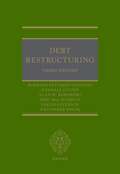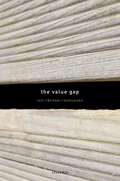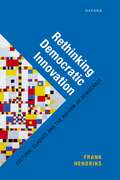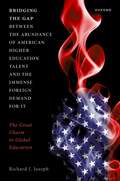- Table View
- List View
Whistleblowing: Law and Practice
by Jack Mitchell Jeremy Lewis John Bowers QC Martin FodderWhistleblowing: Law and Practice is the leading reference work on whistleblowing law and practice in England and Wales, offering up-to-date, practical guidance on the key issues that arise in practice, and making use of checklists and worked examples. The book provides comprehensive coverage of the protection given to whistleblowers by the Employment Rights Act and other legislation, and the way in which the European Convention on Human Rights affects the approach to statutory interpretation. It also provides a detailed survey of the principles of the common law and equity as they relate to whistleblowing, and the interface between copyright and defamation law and whistleblowing. The 4th edition of Whistleblowing: Law and Practice provides analysis of judgements made since the previous edition, including the Supreme Court judgements on Royal Mail Group Ltd v Jhuti and Gilham v Ministry of Justice, and Court of Appeal judgements on Kilraine v London Borough of Wandsworth and International Petroleum Ltd and others v Osipov and other. The book also includes changes to NHS and EU legislation regarding whistleblowing.
Debt Restructuring
by Rodrigo Olivares-Caminal Randall Guynn Alan Kornberg Sarah Paterson Eric McLaughlin Dalvinder SinghThe new third edition of Debt Restructuring offers detailed legal analysis of international corporate, banking, and sovereign debt restructuring, from the perspective of creditors and debtors. It provides practical guidance to help practitioners, policy-makers, and academics in the UK and US to understand current developments in debt restructuring, and provides solutions for creditors holding distressed debt and debtor options in a distressed scenario. The Corporate Debt section includes significant changes to highlight the impact of COVID-19 on restructurings, including: potential grounds for investors/lenders to modify or terminate commitments to fund or support restructurings by invoking material adverse effect or force majeure clauses; unprecedented relief granted by insolvency courts to aid ailing retailers; and challenges facing insolvency courts in making necessary confirmation findings regarding the feasibility of reorganization plans due to market instability. This section also includes the recent adoption of the Part 26A Restructuring Plans and the EU Restructuring Directive. Amendments to the Bank Resolution section reflect decisions by the Single Resolution Board, and national authority resolution decisions notified to the European Banking Authority. A new sub-section on domestic bank insolvency and liquidation covers the developments under the Deposit Guarantee Schemes Directive, and a new chapter on insolvency law relating to Insurance Firms addresses the international debate on a special resolution regime for insurance firms. Other updates include the 2017 code of practice, the 'third country' branch model after Brexit, non-equivalence regarding depositor protection arrangements, and the Resolvability Assessment Framework. In the Sovereign Debt section, there is detailed coverage of US and UK developments, examining the increased role of sanctions and the possibility of piercing the corporate veil in SoEs (Chrystallex), as well as the increased push for domestic laws to be used to curtail litigation. It also covers developments in re-designation and the emergence of the 'pac-man technique' in the context of collective action clauses, as a result of the recent restructurings of Argentina and Ecuador. The impact of COVID-19 on the adoption of the Debt Service Suspension Initiative and the Common Framework are also analysed.
Debt Restructuring
by Dalvinder Singh Sarah Paterson Rodrigo Olivares-Caminal Alan Kornberg Eric McLaughlinThe new third edition of Debt Restructuring offers detailed legal analysis of international corporate, banking, and sovereign debt restructuring, from the perspective of creditors and debtors. It provides practical guidance to help practitioners, policy-makers, and academics in the UK and US to understand current developments in debt restructuring, and provides solutions for creditors holding distressed debt and debtor options in a distressed scenario. The Corporate Debt section includes significant changes to highlight the impact of COVID-19 on restructurings, including: potential grounds for investors/lenders to modify or terminate commitments to fund or support restructurings by invoking material adverse effect or force majeure clauses; unprecedented relief granted by insolvency courts to aid ailing retailers; and challenges facing insolvency courts in making necessary confirmation findings regarding the feasibility of reorganization plans due to market instability. This section also includes the recent adoption of the Part 26A Restructuring Plans and the EU Restructuring Directive. Amendments to the Bank Resolution section reflect decisions by the Single Resolution Board, and national authority resolution decisions notified to the European Banking Authority. A new sub-section on domestic bank insolvency and liquidation covers the developments under the Deposit Guarantee Schemes Directive, and a new chapter on insolvency law relating to Insurance Firms addresses the international debate on a special resolution regime for insurance firms. Other updates include the 2017 code of practice, the 'third country' branch model after Brexit, non-equivalence regarding depositor protection arrangements, and the Resolvability Assessment Framework. In the Sovereign Debt section, there is detailed coverage of US and UK developments, examining the increased role of sanctions and the possibility of piercing the corporate veil in SoEs (Chrystallex), as well as the increased push for domestic laws to be used to curtail litigation. It also covers developments in re-designation and the emergence of the 'pac-man technique' in the context of collective action clauses, as a result of the recent restructurings of Argentina and Ecuador. The impact of COVID-19 on the adoption of the Debt Service Suspension Initiative and the Common Framework are also analysed.
Brexit and the Future of Private International Law in English Courts
by Mukarrum AhmedIn Brexit and the Future of Private International Law in English Courts, Mukarrum Ahmed discusses the impact of Brexit upon jurisdiction, foreign judgments, and the applicable law in civil and commercial matters. By providing a commentary on the principal post-Brexit changes in England, this book faces towards the future of private international law in English courts. It utilises a once-in-a-generation opportunity to analyse, understand, and reframe some fundamental assumptions about the discipline with a view to suggesting adjustments and law reform. Ahmed argues that a conscious unlearning of the central precepts of EU private international law would be detrimental to the future of English private international law. The multilateral issues that lie ahead for the discipline rely on the legal epistemology of EU private international law, which also serves as a useful reference point when comparing aspects of English private international law. Unshackled from the EU's external competence constraints, the UK will have the opportunity to play a more prominent role in the development of the Hague Conference's global instruments. A methodologically pluralist approach to English private international law may be the best route to sustain its global leadership in this field, as well as simultaneously assimilating the best private international law developments from the Commonwealth, Europe, and beyond.
Business and Investment in Brazil: Law and Practice
by Peter SesterBusiness and Investment in Brazil provides a thorough analysis of Brazilian business law for investors and their legal advisers, focusing on topics relevant to business transactions and disputes that can arise in the aftermath of the signing or performance of deals. The essence of investment and negotiation processes is risk evaluation and allocation. Examining Brazilian law through the eyes of an international transaction lawyer, Peter Sester focuses on the legal risks, which are higher in Brazilian law than elsewhere, particularly in comparison with contract, partnership, and company (LLC) laws governing international business transactions in the US and UK. However, whilst Brazilian contract law remains a risk factor as a result of its over-ambitious and consequently interventionist approach, Brazilian law in the areas of stock corporation, capital market, antitrust, and public procurement are state-of-the-art when compared to the US and leading European laws in Germany, Switzerland, and France. This book is divided into eight chapters: the introduction provides an overview of the economic and legal framework for doing business in Brazil, focusing on features of the Brazilian legal and economic order that are unusual to international practitioners from a comparative perspective. The other seven chapters analyze those fields of substantive law that impact most investments and cross-border transactions in Brazil. They include important historical and economic context such as inflation indexation and the broad use of good faith, as well as explorations of common legal pitfalls such as the limited scope of freedom of contract and its mandatory provisions. The book focuses on the interpretation of statutory law by the Brazilian Superior Court of Justice and regulatory agencies, and also provides insights into the economic and business rationale of some of the legal solutions offered.
Business and Investment in Brazil: Law and Practice
by Peter SesterBusiness and Investment in Brazil provides a thorough analysis of Brazilian business law for investors and their legal advisers, focusing on topics relevant to business transactions and disputes that can arise in the aftermath of the signing or performance of deals. The essence of investment and negotiation processes is risk evaluation and allocation. Examining Brazilian law through the eyes of an international transaction lawyer, Peter Sester focuses on the legal risks, which are higher in Brazilian law than elsewhere, particularly in comparison with contract, partnership, and company (LLC) laws governing international business transactions in the US and UK. However, whilst Brazilian contract law remains a risk factor as a result of its over-ambitious and consequently interventionist approach, Brazilian law in the areas of stock corporation, capital market, antitrust, and public procurement are state-of-the-art when compared to the US and leading European laws in Germany, Switzerland, and France. This book is divided into eight chapters: the introduction provides an overview of the economic and legal framework for doing business in Brazil, focusing on features of the Brazilian legal and economic order that are unusual to international practitioners from a comparative perspective. The other seven chapters analyze those fields of substantive law that impact most investments and cross-border transactions in Brazil. They include important historical and economic context such as inflation indexation and the broad use of good faith, as well as explorations of common legal pitfalls such as the limited scope of freedom of contract and its mandatory provisions. The book focuses on the interpretation of statutory law by the Brazilian Superior Court of Justice and regulatory agencies, and also provides insights into the economic and business rationale of some of the legal solutions offered.
The Oxford Handbook of Animal Organization Studies (Oxford Handbooks)
Just as climate change and environmental sustainability have become growing concerns in public discourse, so too have they become a persistent focus in business and organization studies. It is increasingly acknowledged that humans and animals do not dwell in separate spheres; rather, they are entangled in a number of commercial or organizational settings, and organization theory needs to respond more comprehensively to this more-than-human shift in outlook. Important questions continue to arise about the nature of contemporary organization and organizing practices: who are these for? Who benefits from the operation of increasingly globalized capital markets? What place is there for the nonhuman animals in all this organization? What place is there for multispecies companionship, solidarity, and mutual value creation today and in the future, if any? This volume brings together interdisciplinary work on human-animal relationships within business, management, and organization for the first time. It maps the contours of an emerging new discipline, here termed 'Animal Organization Studies', touching on the politics, theory, and empirical experience of multispecies life-worlds. Spanning a number of disciplinary approaches including critical geography, critical management studies, social studies of science, and human-animal studies, the volume highlights the contact points as well as the tensions in humanity's relationship with a range of animal species and habitats. It holds relevance for those investigating debates around humanism and its futures; environmental and sustainability matters; the experience of working with and on animals, and the future of animal consumption and production.
The Oxford Handbook of Animal Organization Studies (Oxford Handbooks)
by Linda Tallberg and Lindsay HamiltonJust as climate change and environmental sustainability have become growing concerns in public discourse, so too have they become a persistent focus in business and organization studies. It is increasingly acknowledged that humans and animals do not dwell in separate spheres; rather, they are entangled in a number of commercial or organizational settings, and organization theory needs to respond more comprehensively to this more-than-human shift in outlook. Important questions continue to arise about the nature of contemporary organization and organizing practices: who are these for? Who benefits from the operation of increasingly globalized capital markets? What place is there for the nonhuman animals in all this organization? What place is there for multispecies companionship, solidarity, and mutual value creation today and in the future, if any? This volume brings together interdisciplinary work on human-animal relationships within business, management, and organization for the first time. It maps the contours of an emerging new discipline, here termed 'Animal Organization Studies', touching on the politics, theory, and empirical experience of multispecies life-worlds. Spanning a number of disciplinary approaches including critical geography, critical management studies, social studies of science, and human-animal studies, the volume highlights the contact points as well as the tensions in humanity's relationship with a range of animal species and habitats. It holds relevance for those investigating debates around humanism and its futures; environmental and sustainability matters; the experience of working with and on animals, and the future of animal consumption and production.
The Value Gap
by Toni Rønnow-RasmussenIn The Value Gap, Toni Rønnow-Rasmussen addresses the distinction between what is finally good and what is finally good-for, two value notions that are central to ethics and practical deliberation. The first part of the book argues against views that claim that one of these notions is either faulty, or at best conceptually dependent on the other notion. Whereas these two views disagree on whether it is good or good-for that is the flawed or dependent concept, it is argued, as against both approaches, that goodness and goodness-for are independent value notions that cannot be fully understood in terms of one another. The second part provides an analysis of good and good-for in terms of a fitting-attitude analysis. By elaborating a more nuanced understanding of the key elements of this analysis—reasons and pro-attitudes—Rønnow-Rasmussen challenges the widespread idea that there are no genuine practical and moral dilemmas. The result is that the gap between favouring for a reason what is good and favouring for a reason what is good for someone appears insurmountable.
The Value Gap
by Toni Rønnow-RasmussenIn The Value Gap, Toni Rønnow-Rasmussen addresses the distinction between what is finally good and what is finally good-for, two value notions that are central to ethics and practical deliberation. The first part of the book argues against views that claim that one of these notions is either faulty, or at best conceptually dependent on the other notion. Whereas these two views disagree on whether it is good or good-for that is the flawed or dependent concept, it is argued, as against both approaches, that goodness and goodness-for are independent value notions that cannot be fully understood in terms of one another. The second part provides an analysis of good and good-for in terms of a fitting-attitude analysis. By elaborating a more nuanced understanding of the key elements of this analysis—reasons and pro-attitudes—Rønnow-Rasmussen challenges the widespread idea that there are no genuine practical and moral dilemmas. The result is that the gap between favouring for a reason what is good and favouring for a reason what is good for someone appears insurmountable.
Waiting on Empire: A History of Indian Travelling Ayahs in Britain
by Arunima DattaThe expansion of the British Empire facilitated movement across the globe for both the colonizers and the colonized. Waiting on Empire focuses on a largely forgotten group in this story of movement and migration: South Asian travelling ayahs (servants and nannies), who travelled between India and Britain and often found themselves destitute in Britain as they struggled to find their way home to South Asia. Delving into the stories of individual ayahs from a wide range of sources, Arunima Datta illuminates their brave struggle to assert their rights, showing how ayahs negotiated their precarious employment conditions, capitalized on social sympathy amongst some sections of the British population, and confronted or collaborated with various British institutions and individuals to demand justice and humane treatment. In doing so, Datta re-imagines the experience of waiting. Waiting is a recurrent human experience, yet it is often marginalized. It takes a particular form within complex bureaucratized societies in which the marginalized inevitably wait upon those with power over them. Those who wait are often discounted as passive, inactive victims. This book shows that, in spite of their precarious position, the travelling ayahs of the British empire were far from this stereotype.
Waiting on Empire: A History of Indian Travelling Ayahs in Britain
by Dr Arunima DattaThe expansion of the British Empire facilitated movement across the globe for both the colonizers and the colonized. Waiting on Empire focuses on a largely forgotten group in this story of movement and migration: South Asian travelling ayahs (servants and nannies), who travelled between India and Britain and often found themselves destitute in Britain as they struggled to find their way home to South Asia. Delving into the stories of individual ayahs from a wide range of sources, Arunima Datta illuminates their brave struggle to assert their rights, showing how ayahs negotiated their precarious employment conditions, capitalized on social sympathy amongst some sections of the British population, and confronted or collaborated with various British institutions and individuals to demand justice and humane treatment. In doing so, Datta re-imagines the experience of waiting. Waiting is a recurrent human experience, yet it is often marginalized. It takes a particular form within complex bureaucratized societies in which the marginalized inevitably wait upon those with power over them. Those who wait are often discounted as passive, inactive victims. This book shows that, in spite of their precarious position, the travelling ayahs of the British empire were far from this stereotype.
The Tudor Sheriff: A Study in Early Modern Administration
by Jonathan McGovernSheriffs were among the most important local office-holders in early modern England. They were generalist officers of the king responsible for executing legal process, holding local courts, empanelling juries, making arrests, executing criminals, collecting royal revenue, holding parliamentary elections, and many other vital duties. Although sheriffs have a cameo role in virtually every book about early modern England, the precise nature of their work has remained something of a mystery. The Tudor Sheriff offers the first comprehensive analysis of the shrieval system between 1485 and 1603. It demonstrates that this system was not abandoned to decay in the Tudor period, but was effectively reformed to ensure its continued relevance. Jonathan McGovern shows that sheriffs were not in competition with other branches of local government, such as the Lords Lieutenant and justices of the peace, but rather cooperated effectively with them. Since the office of sheriff was closely related to every other branch of government, a study of the sheriff is also a study of English government at work.
The Tudor Sheriff: A Study in Early Modern Administration
by Jonathan McGovernSheriffs were among the most important local office-holders in early modern England. They were generalist officers of the king responsible for executing legal process, holding local courts, empanelling juries, making arrests, executing criminals, collecting royal revenue, holding parliamentary elections, and many other vital duties. Although sheriffs have a cameo role in virtually every book about early modern England, the precise nature of their work has remained something of a mystery. The Tudor Sheriff offers the first comprehensive analysis of the shrieval system between 1485 and 1603. It demonstrates that this system was not abandoned to decay in the Tudor period, but was effectively reformed to ensure its continued relevance. Jonathan McGovern shows that sheriffs were not in competition with other branches of local government, such as the Lords Lieutenant and justices of the peace, but rather cooperated effectively with them. Since the office of sheriff was closely related to every other branch of government, a study of the sheriff is also a study of English government at work.
Oxford Handbook of Sleep Medicine (Oxford Medical Handbooks)
The Oxford Handbook of Sleep Medicine provides a comprehensive, practical guide to clinicians of all backgrounds for the diagnosis and treatment of sleep disorders across clinical specialties. Sleep medicine is encountered in almost every field of medicine yet clinical training and practical guidance is often difficult to find. This handbook is essential for all clinicians seeking a clear and concise quick-reference guide to sleep disorders in their day-to-day practice, from the GP to specialists in respiratory medicine, psychiatry, neurology and surgery. It will also provide an excellent resource for those pursuing specialist training in clinical sleep medicine. This handbook is written from a practical perspective, to guide clinical practice, rather than providing simply theoretical knowledge. It provides guidance from experienced clinicians across a range of specialties to provide a truly comprehensive multidisciplinary approach to sleep medicine. This handbook covers the full range of sleep disorders, from insomnia to very rare movement disorders, to ensure the reader has quick access to the right information whenever they need it.
Oxford Handbook of Sleep Medicine (Oxford Medical Handbooks)
by Guy LeschzinerThe Oxford Handbook of Sleep Medicine provides a comprehensive, practical guide to clinicians of all backgrounds for the diagnosis and treatment of sleep disorders across clinical specialties. Sleep medicine is encountered in almost every field of medicine yet clinical training and practical guidance is often difficult to find. This handbook is essential for all clinicians seeking a clear and concise quick-reference guide to sleep disorders in their day-to-day practice, from the GP to specialists in respiratory medicine, psychiatry, neurology and surgery. It will also provide an excellent resource for those pursuing specialist training in clinical sleep medicine. This handbook is written from a practical perspective, to guide clinical practice, rather than providing simply theoretical knowledge. It provides guidance from experienced clinicians across a range of specialties to provide a truly comprehensive multidisciplinary approach to sleep medicine. This handbook covers the full range of sleep disorders, from insomnia to very rare movement disorders, to ensure the reader has quick access to the right information whenever they need it.
Oxford Handbook of Head and Neck Anatomy (Oxford Medical Handbooks)
by Daniel R. van Gijn Jonathan DunneThe Oxford Handbook of Head and Neck Anatomy offers a succinct yet comprehensive quick reference guide with over 400 schematic colour and grey-scale illustrations. It tackles the notoriously difficult three-dimensional anatomy of the head and neck and provides essential clinico-anatomical correlates, etymology and background insight to help the reader easily remember complex features. Written and illustrated throughout with an awareness of the difficulties faced in linking the anatomy on the page with real cases seen in day-to-day clinical practice, this handbook is an essential resource for trainees and students at all levels.
Oxford Handbook of Head and Neck Anatomy (Oxford Medical Handbooks)
by Jonathan Dunne Daniel R. van GijnThe Oxford Handbook of Head and Neck Anatomy offers a succinct yet comprehensive quick reference guide with over 400 schematic colour and grey-scale illustrations. It tackles the notoriously difficult three-dimensional anatomy of the head and neck and provides essential clinico-anatomical correlates, etymology and background insight to help the reader easily remember complex features. Written and illustrated throughout with an awareness of the difficulties faced in linking the anatomy on the page with real cases seen in day-to-day clinical practice, this handbook is an essential resource for trainees and students at all levels.
International Law
by Gleider HernándezInternational Law presents a comprehensive yet student-focused approach to the subject, providing a contemporary and stimulating account of international law. With critical coverage delivered through a wide range of learning features, students are encouraged to engage with legal debates and controversies. Digital formats and resources The second edition is available for students and institutions to purchase in a variety of formats, and is supported by online resources. · The e-book offers a mobile experience and convenient access along with functionality tools, navigation features and links that offer extra learning support: www.oxfordtextbooks.co.uk/ebooks There is also a wide range of online resources that support the book, including: · Author tutorial videos for each chapter · Discussion questions · Critical thinking frameworks · A glossary of international law terms · A history of international law timeline
International Law
by Gleider HernándezInternational Law presents a comprehensive yet student-focused approach to the subject, providing a contemporary and stimulating account of international law. With critical coverage delivered through a wide range of learning features, students are encouraged to engage with legal debates and controversies. Digital formats and resources The second edition is available for students and institutions to purchase in a variety of formats, and is supported by online resources. · The e-book offers a mobile experience and convenient access along with functionality tools, navigation features and links that offer extra learning support: www.oxfordtextbooks.co.uk/ebooks There is also a wide range of online resources that support the book, including: · Author tutorial videos for each chapter · Discussion questions · Critical thinking frameworks · A glossary of international law terms · A history of international law timeline
Rethinking Democratic Innovation: Cultural Clashes and the Reform of Democracy
by Prof Frank HendriksRethinking Democratic Innovation takes a fresh look at diverging visions of improving democratic governance and asks whether these existing tensions could be made productive. Could different visions of democratic revitalisation complement and correct each other in ways that are good for democracy? Is it conceivable that combined approaches address a larger part of the democratic challenge, while isolated approaches, centralizing deliberative or plebiscitary democracy, are confined to more limited areas of concern? This book ultimately provides an affirmative answer, outlining the scope for hybrid democratic innovations that thrive on exploiting, not eliminating, tensions between diverging visions of improved democracy. Supplementing democratic theory with a cultural perspective, this book contributes to a deeper understanding of plans and methods geared toward improving democratic governance. Revisiting Mary Douglas's seminal take on culture as pollution reduction, processes of democratic innovation are understood as instances of cultural cleaning in public governance. The book recognizes that democratic cleaning will never be finished but can be done in ways that are more productive. Reflecting on varieties of hybrid democratic innovation - deliberative referendums, participatory budgeting-new style, and more - the author posits that more versatile, connective, and embedded innovations stand a better chance of high performance on a broader spectrum than democratic innovations falling short of these qualities.
Rethinking Democratic Innovation: Cultural Clashes and the Reform of Democracy
by Prof Frank HendriksRethinking Democratic Innovation takes a fresh look at diverging visions of improving democratic governance and asks whether these existing tensions could be made productive. Could different visions of democratic revitalisation complement and correct each other in ways that are good for democracy? Is it conceivable that combined approaches address a larger part of the democratic challenge, while isolated approaches, centralizing deliberative or plebiscitary democracy, are confined to more limited areas of concern? This book ultimately provides an affirmative answer, outlining the scope for hybrid democratic innovations that thrive on exploiting, not eliminating, tensions between diverging visions of improved democracy. Supplementing democratic theory with a cultural perspective, this book contributes to a deeper understanding of plans and methods geared toward improving democratic governance. Revisiting Mary Douglas's seminal take on culture as pollution reduction, processes of democratic innovation are understood as instances of cultural cleaning in public governance. The book recognizes that democratic cleaning will never be finished but can be done in ways that are more productive. Reflecting on varieties of hybrid democratic innovation - deliberative referendums, participatory budgeting-new style, and more - the author posits that more versatile, connective, and embedded innovations stand a better chance of high performance on a broader spectrum than democratic innovations falling short of these qualities.
Bridging the Gap between the Abundance of American Higher Education Talent and the Immense Foreign Demand for It: The Great Chasm in Global Education
by Richard J. JosephThe gap between the abundance of American higher education talent and the immense foreign demand for it is the great chasm in global education. It is a gulf of lost opportunities. It is also a space of great economic potential. This book describes the great chasm, examines factors underlying it, and suggests ways to bridge the gap to realize this potential. The abundance of talent stems from the slackening growth of the U.S. higher education sector in the New Millennium. Contributing to the slowdown are flat enrollments, adverse demographic trends, U.S. visa restrictions, and intensifying competition. The immense foreign demand has been fueled by the secular expansion of the global economy. It has been shaped by the pressing need in emerging markets to develop an educated workforce. The great chasm creates an opportunity for American academic institutions to extend their global reach. Bridging the gap, however, is not an easy feat for most U.S. colleges and universities. It is complicated by an institutional culture that is averse to commercialization, an organizational structure that is operationally slow, and a governance system that often leads to indecision, conflict, and paralysis. Bridging the gap requires fundamental changes in the culture, organization, and governance of traditional U.S. academic institutions. These changes will pave the way for international expansion, which could enhance the financial well-being of these institutions, the social-well-being of less developed nations, and the critical role that America plays globally in knowledge creation, the dissemination of ideas, and the pursuit of the truth.
Bridging the Gap between the Abundance of American Higher Education Talent and the Immense Foreign Demand for It: The Great Chasm in Global Education
by Richard J. JosephThe gap between the abundance of American higher education talent and the immense foreign demand for it is the great chasm in global education. It is a gulf of lost opportunities. It is also a space of great economic potential. This book describes the great chasm, examines factors underlying it, and suggests ways to bridge the gap to realize this potential. The abundance of talent stems from the slackening growth of the U.S. higher education sector in the New Millennium. Contributing to the slowdown are flat enrollments, adverse demographic trends, U.S. visa restrictions, and intensifying competition. The immense foreign demand has been fueled by the secular expansion of the global economy. It has been shaped by the pressing need in emerging markets to develop an educated workforce. The great chasm creates an opportunity for American academic institutions to extend their global reach. Bridging the gap, however, is not an easy feat for most U.S. colleges and universities. It is complicated by an institutional culture that is averse to commercialization, an organizational structure that is operationally slow, and a governance system that often leads to indecision, conflict, and paralysis. Bridging the gap requires fundamental changes in the culture, organization, and governance of traditional U.S. academic institutions. These changes will pave the way for international expansion, which could enhance the financial well-being of these institutions, the social-well-being of less developed nations, and the critical role that America plays globally in knowledge creation, the dissemination of ideas, and the pursuit of the truth.
A Church Militant: Anglicans and the Armed Forces from Queen Victoria to the Vietnam War
by Michael SnapeThis is a study of the relationship between Anglicans and the armed forces, of the military heritage and history of the Anglican Communion, and the changing nature of this relationship between the mid-Victorian period and the 1970s. This era spanned a period of imperial expansion and colonial conflict round the turn of the twentieth century, the two World Wars, the Cold War, wars of decolonisation, and Vietnam. In terms of armed conflict, it was the bloodiest period in the history of humanity and marked the advent of weaponry that had the capacity to extinguish human civilization. This book assesses the contribution of an expansive Anglican Communion to the armed forces of the English-speaking world, examines the ways in which this has been remembered, and explores its challenging legacy for the twenty-first century Church of England.













